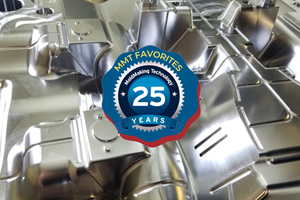Creating an Effective Supplier Management Scorecard
Keeping Up with ISO columnist, Lewis Yasenchak wants to help moldmakers measure performance metrics across their supply chain with this quick-read. How often do you check your supplier management scorecard?

Keeping Up with ISO series columinst, Lewis Yasenchak asks, How often do mold builders check their supplier management scorecard? Here, he provides insight on how to measure performance metrics across the moldmaking supply chain. It's no longer enough to just create a lean supply chain. You must look deeper into supplier management and supplier performance to maximize value, reduce risks and control associated costs. This involves more than cost cutting. It requires monitoring and measuring the performance of suppliers. I'll allow Lewis to explain.
Welcome! You’ve unlocked premium content.
We are doing business in a world that is increasingly reliant on a global supply chain, and supplier performance must be effectively calculated and evaluated for efficiency. Global trading options are certainly not getting any smaller, and with countries like China and Russia rapidly expanding their footprint in the free market economy, supplier performance and supplier management are reaching a critical point. Organizations no longer have the luxury of looking at their suppliers as simply a cost. They must look to suppliers as a strategic aspect of their bottom line. Therefore, insight into performance metrics has become critical across the supply chain.
Align your goals. Effective supplier management can be simple to implement, but it will require your goals to be aligned with the organization’s efforts. Good business processes will have to be established to measure performance, and clear communication with senior management is vital to see success. While outsourcing requires a better grasp on supplier performance metrics, simply implementing policies to squeeze efficiency out of the supply chain will get you nowhere without support.
Take a step back. Step back and take a look at your supplier management practices. Do you notice an increase in the complexity of managing your suppliers? Are you seeing an increased number of supply risks? These elements are indicative of the need for an increased focus on supply chain metrics. They show that you need an effective performance measurement system. Now that you have identified a need, it’s essential that you share your concerns with executive management in a way that aligns the goals of the organization with the needs of the supply chain. You are much more likely to achieve a positive outcome if a business case is created for the company on why supplier management is important to the organization and how improving performance will reduce costs and increase proficiency.
Once that support is gained, your next step is to implement your evaluation techniques. This can be done by using a questionnaire that you distribute to suppliers, or through surveys and existing company data. Choose the best and most reliable method for the supplier management needs that you have. For example, if you’re looking at on-time delivery and quality of products, the data that you collect should come from your own internal business systems to ensure accuracy.
Measure, monitor and evaluate. Next, you can determine how the evaluation criteria relate to the characteristics you are measuring. Do the measurements relate to strategies and goals? For example, when it comes to on-time delivery, you need to ensure that the supplier management method you choose uses leading and lagging indicators. This will allow you to show how proper delivery has affected business in the past, and how improvements will benefit future business.
As you implement this scorecard policy, helping to track supplier management, you will see an improvement in the acts of suppliers, simply by displaying your interest in their performance. The goal will be to maintain supplier performance by employing corrective actions, when it is found that supplier performance needs improvement.
While not every supplier will walk away having a perfect report card, you will have reliable quantitative measures of performance with which to gauge supplier management and improve your ROI. This supplier management system will give you the feedback you need to then implement a more effective program. Consider bringing on a consultant or a supply chain risk management partner that can help you to pre-screen and prequalify contractors for the qualifications you need them to have.
Now that you have identified the issues and what improvements need to be made, these outside resources will be more equipped to help you directly. Supplier performance management will allow you to reduce risks, lessen administrative burden, lower costs and create a leaner system. Implementing these procedures will bring you one step closer to creating a more efficient supply chain for the company as a whole.
Related Content
The Role of Social Media in Manufacturing
Charles Daniels CFO of Wepco Plastics shares insights on the role of social media in manufacturing, how to improve the “business” side of a small mold shop and continually developing culture.
Read MoreQuestions and Considerations Before Sending Your Mold Out for Service
Communication is essential for proper polishing, hot runner manifold cleaning, mold repair, laser engraving and laser welding services.
Read MoreLeading Mold Manufacturers Share Best Practices for Improving Efficiency
Precise Tooling Solutions, X-Cell Tool and Mold, M&M Tool and Mold, Ameritech Die & Mold, and Cavalier Tool & Manufacturing, sit down for a fast-paced Q&A focused on strategies for improving efficiencies across their operations.
Read MoreHands-on Workshop Teaches Mold Maintenance Process
Intensive workshop teaches the process of mold maintenance to help put an end to the firefighting culture of many toolrooms.
Read MoreRead Next
Keeping Up with ISO: A New High-Level Structure, Part 2
Here's a look at Clauses 4.0-6.0 in ISO 9001:2015.
Read MoreAre You a Moldmaker Considering 3D Printing? Consider the 3D Printing Workshop at NPE2024
Presentations will cover 3D printing for mold tooling, material innovation, product development, bridge production and full-scale, high-volume additive manufacturing.
Read MoreReasons to Use Fiber Lasers for Mold Cleaning
Fiber lasers offer a simplicity, speed, control and portability, minimizing mold cleaning risks.
Read More




















